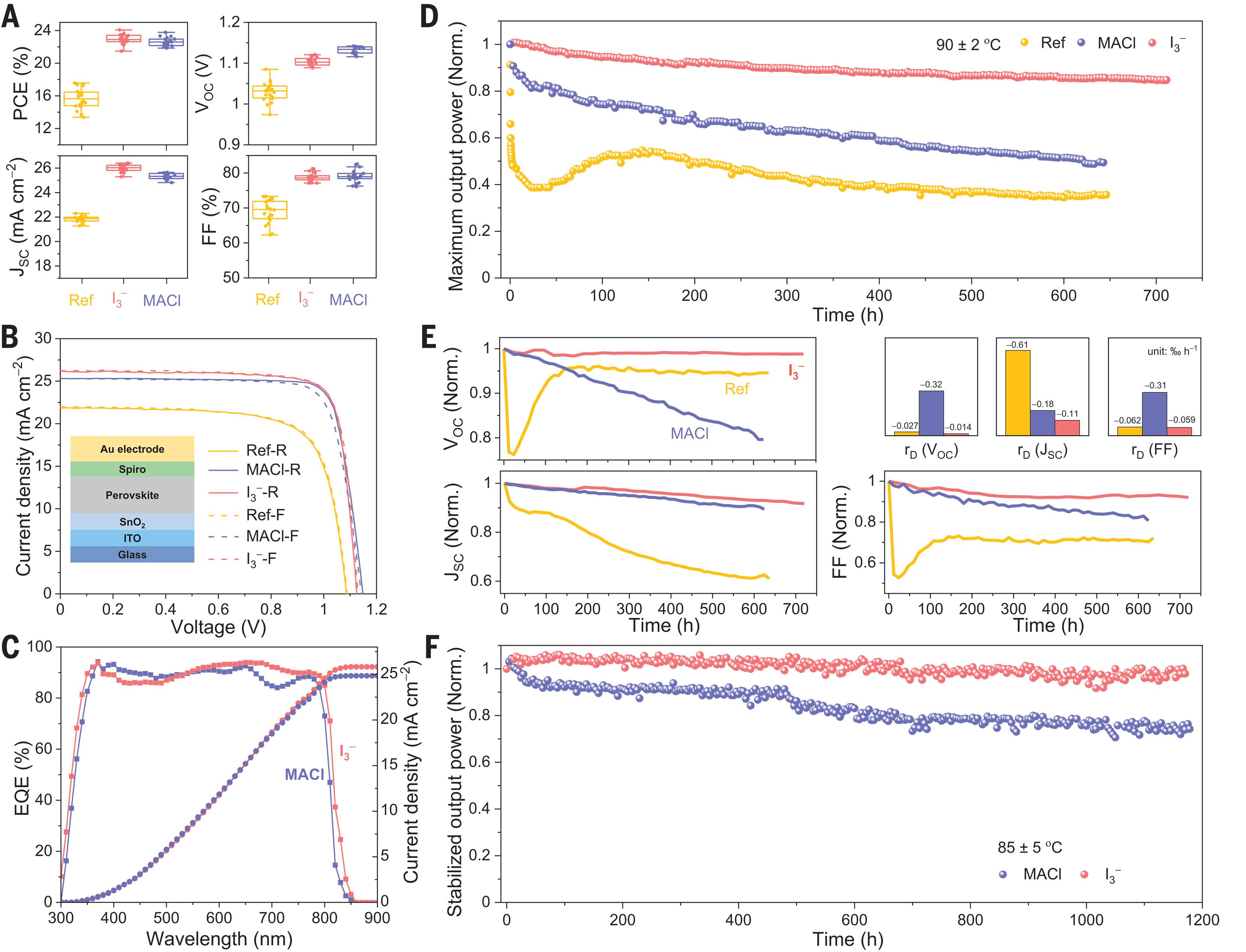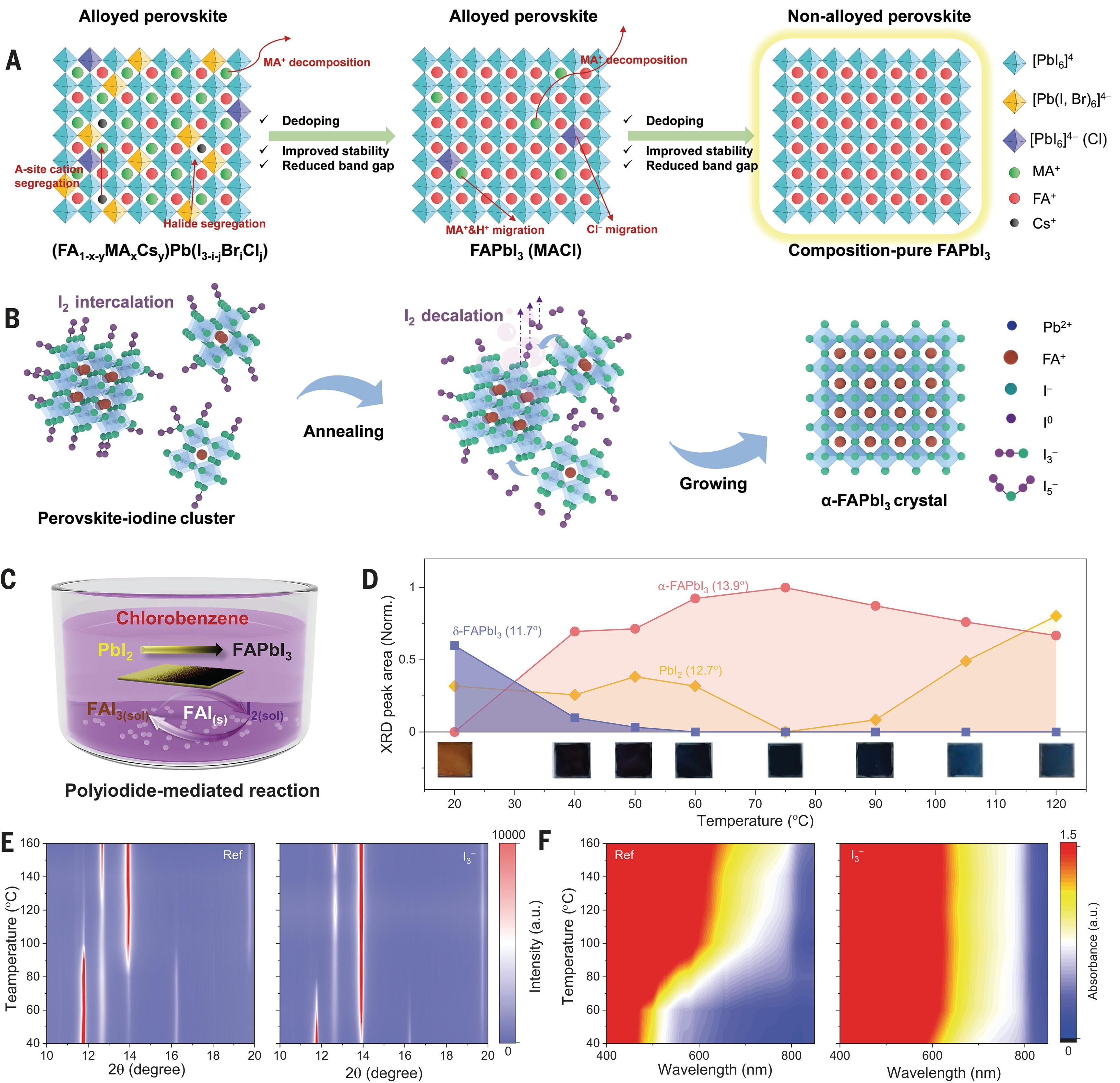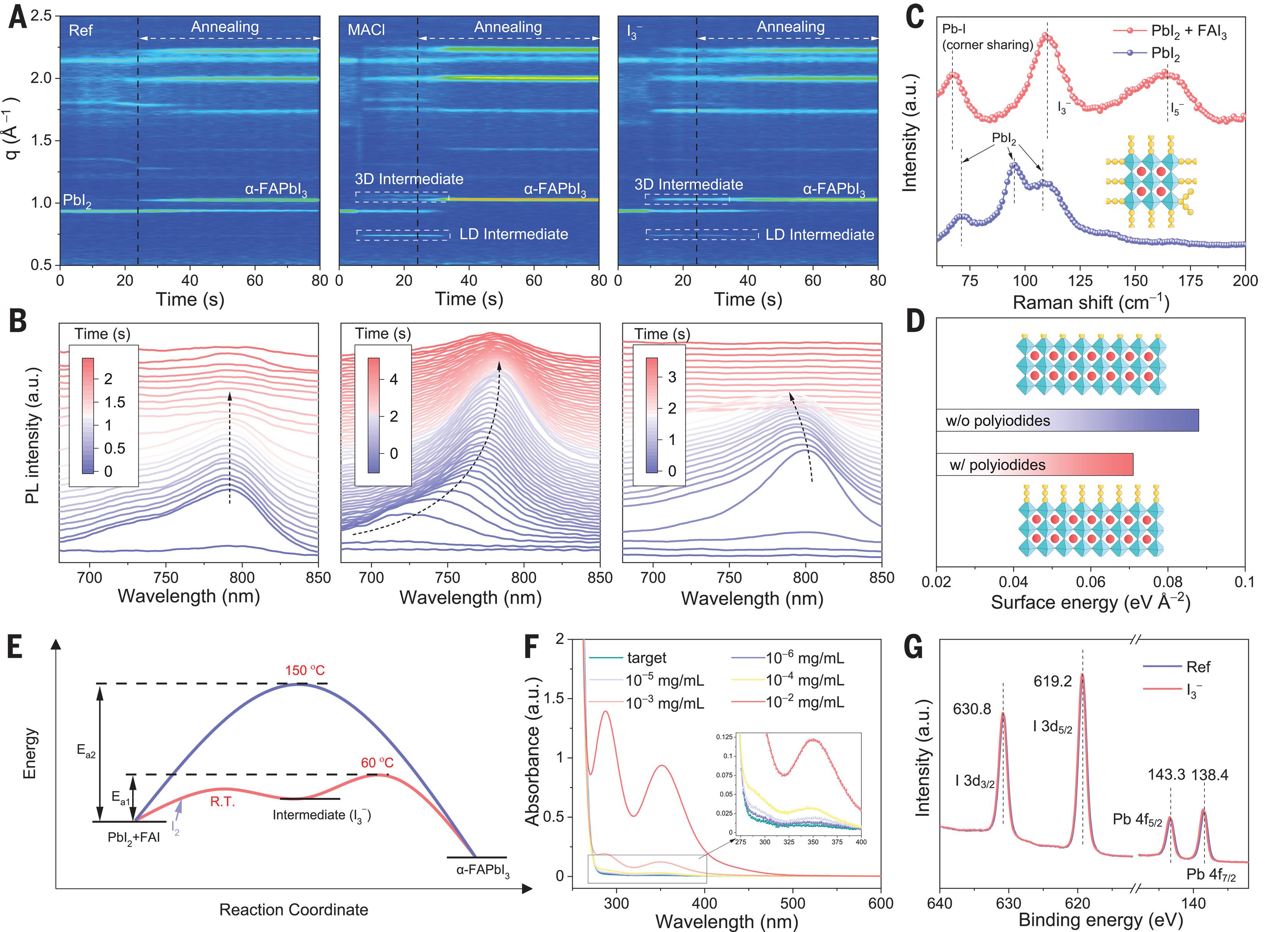Peking University, January 27, 2025: Professor Zhou Huanping, from the School of Materials Science and Engineering at Peking University, has made remarkable strides in the field of perovskite solar cells. Notably, two of the trailblazing works conducted by her research team were featured consecutively in the prestigious Science Journal within a week: “Wafer-scale monolayer MoS2 film integration for stable, efficient perovskite solar cells” (published on January 9, 2025) and “Nonalloyed α-phase formamidinium lead triiodide solar cells through iodine intercalation” (published on January 16, 2025). These impressive accomplishments underscore the global impact of Professor Zhou and her team’s innovations in photovoltaic technology, addressing the challenges in achieving stability and high efficiency in perovskite solar cells.
A probe into “Nonalloyed α-phase formamidinium lead triiodide solar cells through iodine intercalation”
Why it Matters:
Given its photovoltaic properties, low cost and thermal stability, Formamidinium lead triiodide (FAPbI3) has served as a competitive optimal absorber for high-efficiency single-junction perovskite solar cells but is prone to complex crystallization kinetics and thermodynamic metastability at room temperature, presenting huge challenges in its crystallization quality and stability in practical applications. While alloying strategies such as adding methylammonium hydrochloride and Cs+ can effectively control the crystallization process and photoelectric properties of formamidinium-based perovskites films, it may leave behind residual compositional additives that often lead to cation-anion separation, thermal decomposition and potential nucleophilic reactions. Such obstacles complicate the preparation of high quality, non-alloyed α-FAPbI3 perovskite films and related devices.
Professor Zhou, alongside her project group, proposed an innovative iodine intercalation-decalation strategy to produce high-quality, nonalloyed α-FAPbI3 perovskite films, thereby improving the efficiency and stability of perovskite solar cells.
Key Findings:
Fig. 1. Design principle and proof of concept for iodine-mediated formation of nonalloyed α-FAPbI3.
(A) Schematics of nonalloyed perovskite component design and advantages. (B) Schematics of mechanism for iodine-mediated formation of α-FAPbI3. (C) Schematics of α-FAPbI3 converted from PbI2 films immersed in CB with soluble iodine and FAI solids. (D) Integration of α-FAPbI3, δ-FAPbI3, and PbI2 XRD peak areas at different reaction temperatures. (E) XRD patterns for FAI (left) or FAI + I2 (right) spin-coated on PbI2 films as a function of annealing temperature. (F) UV–vis absorption spectra for FAI (left) or FAI + I2(right) spin-coated on PbI2 films as a function of annealing temperature.
The strong bonding between cogenetic iodine (I2) and I− forms polyiodide ions, which changes the original FAI+PbI2→FAPbI3 reaction path to FAI3+PbI2→FAPbI3+I2., thus conducive to overcoming the barrier in α-FAPbI3 formation. Furthermore, owing to its volatility property, I2 is removed from the lattice during annealing, ensuring the absence of any extrinsic residue on the high-quality, nonalloyed α-FAPbI3 film.
Fig. 2. Mechanism of iodine-mediated FAPbI3 film formation.
(A) In situ GIWAXS of Ref, MACl, and I3− samples during spin coating and annealing at 120°C. (B) In situ PL spectra of Ref, MACl, and I3− samples during spin coating. (C) Raman spectra of PbI2 and polyiodide-coordinated perovskite intermediate. (D) Calculated surface energies of perovskite clusters with or without polyiodide coordination. (E) Scheme of energy variation as a function of reaction coordinate for the reaction FAI + PbI2 → FAPbI3 with or without polyiodides. (F) UV-vis absorption spectra of potential residual I0 dissolved in aqueous solution from perovskite, compared with the absorption spectra of I0 solutions at quantified concentrations. (G) XPS spectra of Pb 4f and I 3d of perovskite films.
The nonalloyed α-FAPbI3 film produced from the iodine intercalation-decalation reaction demonstrates a substantial improvement in the crystal quality and uniformity. In addition, enhanced thermal stability of the film inhibits ion migration. The nonalloyed α-FAPbI3 film-based solar cells exhibit a power conversion efficiency of over 24% and retained 99% of their original efficiency after more than 1100 hours of operation at 85℃ under illumination.

Fig. 3. Film quality and stability.
PL spectra (A) of perovskite films and EL spectra (B) of PSCs. (C) EQEEL measurements of the devices under bias from 1 to 2 V. PL intensity mapping (D) and TRPL mapping (E) of perovskite films. (F) Evolution of the ratio between PbI2 and perovskite (001) peak intensity in XRD patterns of Ref, MACl, and I3− films during aging at 85 °C. (G) PL images of ITO/perovskite/ITO devices under a constant applied bias (1 V/μm). The bright areas represent PL emission from the perovskite films. (H) Linear fit of 2θ-sin2ϕ for residual stress in perovskite films, where 2θ stands for diffraction angle and ϕ stands for the angle between the diffraction vector and the sample normal direction.
Significance:
Iodine Chemical Strategy: The crystal quality and stability of films can be significantly improved by altering the perovskite crystallization process through iodine chemical strategies.
High-quality, Nonalloyed α-FAPbI3: The high-quality, nonalloyed α-FAPbI3 film formed utilizing the iodine chemical strategy underpins the formation of intrinsically stable perovskite materials which can be applied in future research and promote the continual development of perovskite photovoltaic technology.
Novel Approach to Modulation: This research provides new insights into the dynamic modulation of metastable perovskites and other optoelectronic materials with a soft ionic lattice, while also breaking new ground in modulation pathways.
About the Research Project:
The research project has gained support by various partners, including the National Natural Science Foundation of China, Natural Science Foundation of Beijing, National Key Research and Development Program of China, and New Cornerstone Science Foundation.
Link to the Paper: https://www.science.org/doi/pdf/10.1126/science.ads8968
Written by: Rachel Lee
Edited by: He Yike
Source: PKU News (Chinese)


